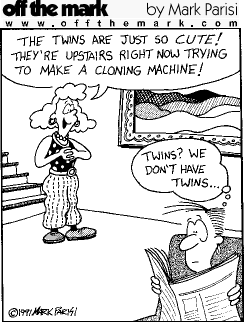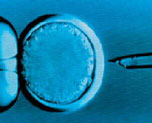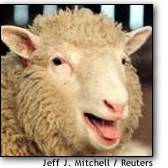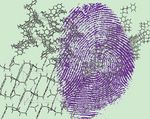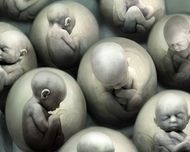Cloning
Contents
Cloning
GROUP 4: Candace Breen, Matthew Wong, Manpreet Nahil, Maria Habib
Introduction
Many years ago, if one were to say that they were going to clone an animal or a living being, they would be laughed at and told not to watch so many science fiction movies. However, Science has progressed so much over years that such an idea doesn't seem so preposterous anymore. Modern day science can now permit scientists to take DNA from one living organism and insert it into another self-replicating organism so they have identical DNA. Cloning has become a very controversial issue in recent years mostly due to developments in cloning technologies. As improvements in cloning technologies develop over the years, it raises many issues in society, including moral and ethical ones. The main question that one must ask themself is that if it were possible to clone human beings, would they? Cloning technologies are at the center of alot of controversy, there are however many sides to this issue. Some believe that cloning technologies are a breakthrough in the world of science and should continue to develop and advance. There are however, those who believe that cloning technologies had advanced way too much and can posssibly lead to human cloning and must be stopped.
The project statement of this group is to present our argument which is against technologies that may permit scientists to clone humans, and then give both sides to this issue.
History
Although cloning has become quite popular in the recent years, scientists have been experimenting with various cloning technologies for many many years. Cloning dates all the way back to the late 1800s when Hans Dreisch unintentionally cloned the first animal.Dreisch’s experiments involved sea urchins because they have large embryos and grow independently from their mothers. He took a two-celled embryo and shook it in a beaker full of sea water until the embryo separated and each started growing independently to form a whole sea urchin.
In 1902, an embryologist Hans Spemman used a hair from his infant son as a knife to slice and separate a 2-celled embryo of a salamander which grows externally; he later separated a cell from a 16-celled embryo. In these experiments both embryos small and large developed into identical adult salamanders. Spemman called this a ‘fantastical experiment, to remove the genetic material from an adult cell and use it to grow another adult with the same genetic material. In this way he was able to prove that no genetic material was lost when cells divided and grew. Science was progressing well, though there were no other major advances in cloning until November, 1951. A team of scientists in Philadelphia working at the lab of Robert Briggs cloned a frog embryo using a different technique. Previous embryo cloning had been achieved by breaking of a cell from an embryo. This team of scientists however, took the nucleus out of a frog embryo cell and used it to replace the nucleus of an unfertilized frog egg cell. This process is called nuclear transplant, once the egg cell received the nucleus it began to divide and grow. This was the first time that this process was ever used and it continues to be used today, though it has changed and improved over the years.
In 1986, a breakthrough came; two teams working independently but using the same methods announced that they had cloned a mammal. One team was led by Steen Wiladsen in England which had cloned a sheep’s embryo. The other team was led by Neal First in America which had cloned a cow’s embryo. Though these teams had in fact cloned mammals, neither team believed that it was possible to clone a differentiated and matured adult cell. This however, all changed when Dolly was born. On July 5, 1996, the first organism ever to be cloned from adult cells was born. Ian Wilmut and Keith Cmapbell, researchers at the Roslin Institute in Scotland created Dolly. They had created two cloned sheep back in 1995 and used similar techniques to create Dolly. For years prior, Scientists had been trying to clone adult mammals using the nuclear transfer techniques but were unsuccessful. The scientists that cloned Dolly used a new technique, called the Roslin technique. The Roslin technique is similar to nuclear tranfer except that the donor cell is starved and suspended so it matches the state of the enucleated (nucleus removed) egg cell; the two cells are then fused together with an electric shock. The egg cell takes the nucleus and its DNA of the donor and develops into an embryo; the embryo is then placed into a surrogate mother and after a normal pregnancy, a clone is born.
Dolly unlike previous cloned mammals was an exact copy of the adult sheep.As a result of Dolly’s creation and the new possibilities it implied, US President Clinton proposed legislation in 1997 to ban cloning for five years; thousands of biologists and physicians signed a voluntary five year halt on human cloning in the United States. Nineteen European nations also signed a ban on human cloning. The remarkable event of the creation of Dolly brought up a question of great controversy: Are Humans Next? In 2001, a U.S. fertility specialist Panayiotis Zavos and a team of international scientists announced that hundreds of couples had volunteered for an experiment to create cloned children; they said it was designed to help infertile couples bear children. Furthermore, Britain became the first country to legalize the cloning of human embryos; the government had approved a highly controversial measure aimed at allowing research on stem cells found in embryos. The clones created under these new regulations would have to be destroyed after 14 days; the creation of babies by cloning however would remain outlawed.Science has indeed progressed a long way in the past century or so, from cloning vegetables and sea urchins to cloning mammals and adult sheep; could humans be next? Is it possible to create an identical being that is an exact copy of you? Such possibilities don’t just exist in science fiction movies anymore but have become a true reality. Ever since the creation of Dolly the sheep people's interest has been revoked by the posssibility of cloning humans. This topic is higly controversial, and the possibilities are endless. However, just like with everything else in science, cloning has major repercussions and consequences not to mention the moral and ehtical issues.
Our Argument
Cloning is a very controversial subject.In most cases it invovles a lot of risk to create little more than a carbon copy of a living organism, such as human beings. Most people do not see a potential in cloning, instead they see ethical boundaries being crossed when they do not necessarily have to be. Through the experimentation of cloning animals, scientists have found that the risks of cloning out-weigh the benefits. These clones are being affected by Large-offspring Syndrome,genetic mutations, as well as other complications. Along with these complications scientists do not have a complete understanding of how cloning could impact mental development which is a crucial stage in the development of a healthy human.[1]One of the most important reasons against cloning is the fact that it diminishes variation. Variation within any sort of species is important because this variation helps species survive through disease and adaptation. Although these issues are not as big as they used to be thanks to vaccines and a human created ecosystem (cities, towns, etc.)these reasons are still important especially when talking about cloning animals. An example is hip displasia in pure bred dogs. Mutts tend to be more adaptable and healthier.[2] Along with the scientific issues involved in cloning there are also ethical reasons as to why people believe cloning is wrong. Most importantly is that some people believe that an embryo is a living being even though it is still an embryo. Therefore the destruction of this living thing would be ethically wrong; whether it is for research or not. In this case the belief is that one life should not be created in order to destroy it for the life of another. [3]Even though scientific and ethical reasons are the most common examples for the argument against cloning there is another huge factor that a lot of times is not taken into account. This factor is fear. Humans are afraid of the idea of cloning and it's side effects. This fear is natural, it is the fear of the unknown and the fear of the stories and ideas brought about by the topic of cloning. It is not just the fear of cloning that is cause for the argument but what this fear brings. The fear of cloning and the research behind it will cause people, scientists fear, to be less likely to tolerate any sort of research. Thus causing a potential for great benefits from those other types of research to be lost and lives lost because of it.[4]
Even though there are many reasons against cloning there are some positive outlooks on it. The ability to clone a cell, instead of an entire human being, could lead to many benefits such as the creation of a healthy organ for transplant. This organ could be used immediately instead of the patient having to wait to find a donor that matched; not only this but the organ would not be rejected since it is made from the healthy cells of the patients existing organ. Some other positive outcomes of cloning would be the ability to clone sheep for the mass production of human insulin. This could help those affected by diabetes because they wouldn't have to wait for the sexual reproduction of sheep to get the insulin they need to survive.[6]The ability to replicate a cell has also lead to the discovery of genes for certain diseases such as Huntington's Disease. Being able to clone these genes also allows for the study of the disease more thoroughly. [7]This type of cloning in which stem cells are extracted from an embryo and allowed to grow into a piece of human tissue or organ is known as Theraputic cloning. The other type of cloning, such as the replication of an entire living organism, is known as Adult DNA cloning.[8] Along with these examples of cloning that provide a positive outlook on the subject there is also Natural cloning which is unstoppable and unthreatening. An example of natural cloning would be identical twins or plants that use A-sexual reproduction.[9] This type of cloning has been around since the dawn of time and does not pose a threat to society. In fact one in 67 births is twins which is actually quite frequent. [10]
Beneficial Aspects of Cloning
“It's a matter of semantics, because you are creating an identical twin.Cloning is creating a replica of a person or an animal.
This is creating what happens in nature every single day.”
– Hilton Kort
Hilton Kort uses brilliant words to describe a unique view on cloning, this view shows us that cloning isn't as bad as people seem to make it to be. Cloning or genetic modification are only in existence because it shows promise for future improvement to the culture or living style of society. Aside from the benefits of cloning animals, there are many "possible" benefits, that can be brought by cloning. However, it is important that we know the following listed benefits are just possibilities that have shown promise, since cloning is still a very strange aspect to mankind. Basically the people who are in favor of human cloning will say that the technological benefits will clearly outweigh the possible social consequences that may result from cloning. Although cloning can be seen by people as being something immoral, it can also be seen as being a necessity for survival, this can be supported by the following points.
1.Cloning can be used to cure diseases; this is called “gene therapy”. This method can be very useful in curing some diseases. In these cases, a “normal – cloned” gene is introduced into the person with the “defective genes – that may cause diseases”. This normal gene will behave as if there is no defect with the body and the patient will then become better. This method can be used in order to develop cures for cancer and AIDS. Gene therapy is just a part of the broad idea of "human cloning". Human cloning would be able to help infertile couples have the children they were never able to have before.
The current scientific treatments for infertility(pregnancy) are not very successful at all. These treatments are estimated to have approximately a 10% success rate, yet couples still go through these physical and emotionally painful procedures for the small chance of being able to have a family. Through this we can see how much it would mean to infertile couples to have children. With human cloning, this would be possible and increase the success rate exponentially. Human cloning would also be very beneficial in the ability for people to clone parts. It would be beneficial in plastic/cosmetic surgeries because you would be able to use bone, fat, tissue or even cartilage that matches the patient. By using an exact clone, people would be less prone to diseases and illness as a result of treatment. Having a safe procedure would give older patients more ease in taking part in these procedures.
2.Another beneficial aspect of cloning is the ability to improve the quality of crops we eat. It can help plants resist herbicides, pest damage, infections as well as diseases. So far in science, we have able to clone plants such as wheat, rice, maize, soybean, potatoes, as well as many others. These have been produced and can be introduced into agriculture in the near future. The scientists have cloned the gene and also developed markers that allow identification of the three different mutations of the gene. This gene is involved in forming lignin - a plant cell wall hardening substance. So then when the gene is not functioning, or mutated, the cell walls are softer.
The study detailing the gene cloning was published in an issue of Molecular Genetics and Genomics and can even be found on the journal's website at http://link.springer.de/link/service/journals/00438/contents/tfirst.htm. As said by a senior study author named Wilfred Vermerris: "Our research focuses on finding solutions to increase the productivity of plants, the value of cloning this gene is to help us better understand what has changed in these mutants so that we can introduce similar changes in other crops, such as rye grass and corn."
3.Police can also use cloning in helping with investigations with the purpose of identification. This process is called genetic fingerprinting. This can be done by extracting DNA from body fluid, blood, saliva, etc. You can then match the person’s body fluid with the police sample you have produced. By doing this, we can track threats to society as well as offenders that need to be kept on watch. We can also quickly identify people, which can be used for diagnosis and treatment as soon as possible. The biggest problem in medical issues today is the inability to be efficient in identifying people in terms of need. For example in a car crash, if we were able to quickly take a sample from the person and quickly identify the person, we would be able to treat this person as soon as possible. We would not have to take as many tests and we would not have to wonder what allergies or symptoms this person may have.
Concerns With Cloning
“Banning human cloning reflects our humanity. It is the right thing to do. Creating a child through this new method calls into question our most fundamental beliefs. It has the potential to threaten the sacred family bonds at the very core of our ideals and our society. At its worst, it could lead to misguided and malevolent attempts to select certain traits, even to create certain kind of children -- to make our children objects rather than cherished individuals.”
-POPE JOHN PAUL II, speech, Jan. 13, 2003
As Pope John Paul II once said, cloning tampers with most of society and is a problem that goes against Mother Nature. A believer in religion like the Pope believes it’s against god's will to recreate humans without the natural process of breeding, scientists should take that into consideration. There are many other problems with cloning that show why cloning is not a good idea and is an unatural process.
1 . One issue with cloning is that it tampers with human nature, causing many new problems humans must face in the future. The process of creating a clone is done by replicating genetic constitutions. This creates identical gene patterns in the clone compared to the person themselves. If this process continues in the future, many people will have identical genes, therefore weakening the ability of adaptation. This problem doesn’t seem too urgent at the moment but it will be an issue in the future; new diseases that no one has heard of might develop. The sheep clone named Dolly was created in 1997 and was a huge success in cloning history. After that day, people started taking cloning seriously. Once you look at the procedure that took place it is shown that it took 227 tries to make a successful clone. That means one out of 227 clones was a success, those are some really bad chances of achieving success in the future. Chicago physicist Richard Seed had planned on how to make a clone in 1999 but the government had banned this after much debating because it’s a very risky process. If something goes wrong, the clones may be born with retardation or even abnormalities. If a situation like this occurs regarding human clones, what should be the fate of the clone? The clone must live a life full of problems because a handful of scientists went against god's will and human nature. Many attempts have been made on mammals as well in which 30% of clones are affected with large off spring syndromes, which all led to death. If the cloning somehow is successful, arguments have been made that psychological harm could fall upon cloned children. They may lack a sense of individuality and feel there future is worth less than a normal person.
2. Cloning human organs is a smart idea, but the problem with this is that in the process of cloning, undesirable traits may occur. Some might need a new liver or a kidney but what if those organs that people need are defected due to genetic mutation. Some agree with the process of cloning organs, but no one thinks about the questions that will arise as cloning becomes more popular. Such questions that arise are, will this process be cheap? How costly will it be to clone an organ? Can anyone buy an organ? This creates many issues in our society not to mention risks as well. Cloning technologies like other powerful technologies should be used with care and caution and in a controlled way so as to prevent people from cloning everything that has a genetic fingerprint.
3. Different countries have different laws about cloning. Once cloning is introduced more broadly it could become a large issue regarding money and time. Cloning is a tedious process and requires a lot of time to create a single clone. This time could be used more effectively to reasearch something else. Also, alot of money is spent on developing cloning technologies, this money can be utilized in some other way that benefits the whole of society.
Conclusion
Although we do not condone the cloning of humans we do see the positive aspects of cloning in general. Theraputic cloning could be very beneficial in the future and should not be looked down upon because it is a type of cloning. Cloning an entire human being does not really have very man positive aspects but the other types of cloning do. There are concerns as why not to clone but there are also benefits to the experimentation and use of cloning. For this reason only the cloning of an entire human being should be unaccepted in society.
References
Candace:
1.http://www.ornl.gov/sci/techresources/Human_Genome/elsi/cloning.shtml
2.http://www.allaboutpopularissues.org/arguments-against-cloning-faq.htm
3.http://www.cloning.org.au/Documents/final%20cloning%20appeal.pdf
4.http://www.time.com/time/magazine/article/0,9171,999233-2,00.html
5.http://www.medilexicon.com/medicaldictionary.php?t=88457
6.http://science.howstuffworks.com/genetic-science/cloning4.htm
7.http://library.thinkquest.org/28599/cloning3.htm
8.http://www.religioustolerance.org/clo_ther.htm
9.http://library.thinkquest.org/J0113142/NATCLO4.htm
10.http://www.letusreason.org/Current20.htm
Maria:
1.http://library.thinkquest.org/20830/Frameless/Manipulating/Experimentation/Cloning/longdoc.htm
2.http://techluver.com/2007/11/10/is-human-reproductive-cloning-inevitable-a-un-report/
3.http://www.msnbc.com/news/wld/health/brill/cloningtimeline.htm
4.http://findarticles.com/p/articles/mi_qn4158/is_20020105/ai_n9670602
5.http://home.hawaii.rr.com/johns/history.htm#BM1996
6.http://atheism.about.com/library/chronologies/blchron_sci_cloning.htm
7.http://www.millerandlevine.com/cloning/
8.http://www.scienceclarified.com/Ci-Co/Clone-and-Cloning.html
9.http://findarticles.com/p/articles/mi_m0YUG/is_3_15/ai_n17208683?tag=content;col1
10.http://www.reproductivecloning.net/hosting/waite/
Matthew:
1.http://www.sci-education.org.uk/wp-content/uploads/
3.http://www.madacorp.com/img/articles/
4.http://www.ornl.gov/sci/techresources/Human_Genome/elsi/cloning.shtml
5.http://learn.genetics.utah.edu/content/tech/cloning/
6.http://thinkexist.com/quotes/hilton_kort/
7.http://farm2.static.flickr.com/1086/
8.http://science.howstuffworks.com/genetic-science/cloning.htm
9.http://www.as.wvu.edu/~kgarbutt/EvolutionPage/Studentsites/cloningpage/PROS2.html
10.http://library.thinkquest.org/04apr/00774/en/txt/controversy_pro.html
Manpreet:
1.http://www.buzzle.com/articles/pros-and-cons-of-cloning.html
2.http://www.apologeticspress.org/articles/2512
3.http://www.princeton.edu/~bioethic/conferences/99/precepts/pencecloning.html
4.http://www.realpoor.com/Morals_of_Human_Cloning__Pros_and_Cons_t5944.html
5.http://www.udel.edu/physics/scen103/CGZ/conshumancloning.html
6.http://wiki.answers.com/Q/What_are_the_pros_and_cons_of_cloning
7.http://serendip.brynmawr.edu/biology/b103/f00/web1/tamang.html
8.http://www.notable-quotes.com/c/cloning_quotes.html
9.http://learn.genetics.utah.edu/content/tech/cloning/cloningrisks/
10.http://www.ornl.gov/sci/techresources/Human_Genome/elsi/cloning.shtml
